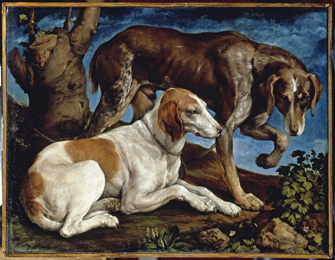 |
|
Titian’s “Danaë” (1544-46). © Scala, Florence |
The Louvre has prepared a wonderful treat for lovers of Italian painting: a trip to 16th-century Venice, where a number of great …
 |
|
Titian’s “Danaë” (1544-46). © Scala, Florence |
The Louvre has prepared a wonderful treat for lovers of Italian painting: a trip to 16th-century Venice, where a number of great painters, led by Titian, Tintoretto and Veronese, competed with each other to demonstrate their mastery and to win major commissions.
Allow plenty of time for a visit to this show – or plan to go back – since almost every one of these 86 sumptuous paintings deserves long study, and you’ll also want to take the time to go back and forth and compare the treatments of the same or similar subjects by one or more painters.
And, for once, the descriptions of each painting are interesting, informative and well worth reading (provided you speak French). Without them, for example, it would be easy to miss the black cat sparring with the much more visible little white dog at the bottom of Titian’s “Supper at Emmaus.” The caption explains that the dog and cat represent the battle between good and evil (without saying which represents which). This wonderful painting is notable for the beatific calm of the Christ figure, contrasting with the very earthy pose of the macho innkeeper, and for the simple, beautifully rendered details on the table, including a loaf of bread and a pyramid of salt.
These three masters not only competed actively with each other for lucrative commissions from rich nobles, the church and the scuole (powerful confraternities), but also copied and took inspiration from each other. When Tintoretto saw Jacopo Bassano’s painting “Two Dogs Tied to a Tree Stump” (the first known example in modern Western painting of animals on their own), for instance, he immediately painted a replica of one of the dogs into his own “Christ Washing the Feet of His Disciples.”
 |
|
Jacopo Bassano’s “Two Dogs Tied to a Tree Stump.” © RMN/Daniel Arnaudet |
The paintings are grouped together by theme – there are several showing the voluptuous Danaë being impregnated by Zeus, who has taken on the form of a shower of gold, for example – to illustrate the similarities and differences between the artists’ styles and interpretations of a subject. Their rivalry also spurred them to innovate and improve. And we see how their work evolved over time as they integrated the Mannerist style into their naturalist vision and strove to prove the superiority of painting over sculpture by giving their works more three-dimensional qualities
If you love painting, do not miss this show.
Musée du Louvre: Hall Napoléon. Métro: Palais-Royal/Musée du Louvre. Tel.: 01 40 20 53 17. Open Wednesday-Monday, 9 a.m.-6 p.m. (until 8 p.m. on Saturday and 10 p.m. on Wednesday and Friday). Closed Tuesday. Admission: €11. Through Jan. 4. www.louvre.fr
More reviews of Paris exhibitions.
Reader Reaction
Click here to respond to this article (your response may be published on this page and is subject to editing).
© 2009 Paris Update
Favorite